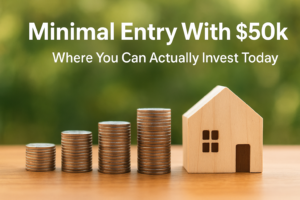New York City Real Estate for Investors: Tips, Strategies, and Forecasts
October 16, 2025
Introduction
New York City is more than just a global cultural icon—it is one of the world’s most resilient and lucrative real estate markets. For investors in 2025, NYC offers unparalleled opportunities in residential, commercial, and mixed-use properties. With over 8.5 million residents and thousands of new developments each year, the city combines high liquidity, long-term appreciation potential, and robust rental demand, making it a top choice for seasoned investors and newcomers alike.
Table of contents for the article
ToggleNavigating this market, however, requires a nuanced understanding of neighborhood dynamics, property types, legal regulations, and tax implications. Recent legislative changes, including the prohibition of AI-driven rent setting and updates to rent stabilization laws, have added layers of complexity. Investors must carefully analyze cash flow projections, ROI, and long-term equity growth to make informed decisions.
This guide offers a detailed, data-driven overview of NYC real estate, including:
Borough-specific housing and rental markets
Investment strategies tailored to different property types
Legal and tax considerations for domestic and foreign investors
Commercial and multi-family opportunities
Scenario-based financial modeling for realistic expectations
By the end, American investors will understand how to structure deals, select profitable neighborhoods, and optimize both short-term and long-term returns in New York City.
Cost of Living and Real Estate Overview
Residential Property Prices by Borough (2025)
For investors, knowing current property values is essential for assessing ROI, rental yield, and equity growth. Median purchase prices and price-per-square-foot ranges are as follows:
| Borough | Median Purchase Price | Price per Sq Ft | Notes |
|---|---|---|---|
| Manhattan | $1,350,000 | $1,500–$2,200 | Luxury-focused market, limited inventory |
| Brooklyn | $950,000 | $850–$1,250 | Strong appreciation, transit-oriented neighborhoods |
| Queens | $650,000 | $650–$950 | Family-friendly, emerging areas |
| Bronx | $520,000 | $450–$750 | Affordable entry, redevelopment potential |
| Staten Island | $560,000 | $400–$700 | Suburban-style living, lower density |
Rental Market Overview
Monthly rental rates (2025 estimates):
| Unit Type | Manhattan | Brooklyn | Queens | Bronx | Staten Island |
|---|---|---|---|---|---|
| Studio | $3,900–$4,600 | $2,900–$3,600 | $2,300–$3,100 | $1,900–$2,600 | $1,500–$2,100 |
| 1-Bedroom | $5,100–$5,900 | $3,600–$4,300 | $2,800–$3,600 | $2,300–$3,100 | $1,900–$2,600 |
| 2-Bedroom | $6,700–$8,200 | $4,600–$5,600 | $3,600–$4,600 | $3,100–$3,900 | $2,600–$3,600 |
| 3-Bedroom | $9,200–$12,200 | $6,100–$7,600 | $4,600–$5,600 | $3,900–$4,600 | $3,100–$4,100 |
Ownership Costs Include:
Mortgage: $2,600–$6,200/month depending on down payment and interest rate
Property Taxes: 6–12% annually based on classification
HOA / Maintenance Fees: $200–$1,500/month
Utilities: $150–$400/month
Example: A two-bedroom condo in Brooklyn at $950,000 with a 20% down payment and a 5.1% mortgage rate would have monthly costs of ~$4,500 including taxes and fees.
Utilities, Taxes, and Lifestyle Expenses
Investors must also consider operating and living costs, particularly if they plan to reside in or manage the property:
Transportation: MetroCard $127/month; car ownership $300–$800/month in outer boroughs
Food and Dining: Groceries $400–$600/month; casual dining $300–$500; luxury dining can exceed $1,000/month
Healthcare: Individual insurance $300–$700/month; co-pays $100–$500
Miscellaneous: Gym memberships $50–$200; entertainment, subscriptions $50–$500
For a single investor living in Brooklyn, total monthly expenses including housing may range $5,000–$6,000, while a family could spend $10,000–$15,000/month.
Neighborhood Analysis
Manhattan
Key Areas: Midtown, Upper East Side, Tribeca, SoHo
Target Market: High-income professionals, executives, and foreign investors
Rental Demand: Extremely strong, vacancy rates <3%
Investment Insight: Manhattan offers prestige, stable long-term appreciation (3–5%), and high liquidity, but entry costs are significant.
Brooklyn
Popular Neighborhoods: Williamsburg, Park Slope, DUMBO
Median 1-Bedroom Purchase: $950,000
Median Rent: $3,800–$4,500/month
Trends: Renovated brownstones, transit-oriented developments, growing family demand
ROI: 5–7% net rental yield; 4–6% annual appreciation
Queens
Hotspots: Long Island City, Astoria, Forest Hills
Median Purchase: $650,000
Median Rent: $2,800–$3,600/month
Opportunities: Emerging neighborhoods, family-friendly schools, access to Manhattan via subway
Investment Potential: High ROI for transit-adjacent properties
Bronx
Neighborhoods: Riverdale, Fordham, South Bronx
Median Purchase: $520,000
Median Rent: $2,300–$3,100/month
Risks: Crime variability, developing infrastructure, selective school ratings
Strategy: Affordable entry, buy-and-hold for long-term appreciation
Staten Island
Characteristics: Suburban-style, larger units, lower density
Median Purchase: $560,000
Median Rent: $1,800–$2,600/month
Investment Approach: Long-term buy-and-hold, stable but slower appreciation
Investment Strategies
Buy-and-Hold
Long-term rental strategy providing steady cash flow and equity growth. Best for Manhattan, Brooklyn, and Queens. Particularly effective in transit-accessible neighborhoods where rental demand is high.
Flipping
High-risk, high-reward strategy: purchase, renovate, and resell within 1–3 years. Ideal in emerging Brooklyn or Queens areas where property appreciation can exceed renovation costs.
Property Types
| Type | Pros | Cons |
|---|---|---|
| Condo | Flexible rental, easier resale | Higher price per sq ft |
| Co-op | Lower upfront costs | Board approval, rental restrictions |
| Multi-Family | Stable cash flow, tax advantages | Management intensive |
Short-Term vs Long-Term Rentals
Short-Term (Airbnb, VRBO): Potentially higher income, subject to regulations
Long-Term: Lower risk, consistent cash flow
Legal and Tax Considerations for NYC Real Estate Investors
Investing in New York City requires a solid understanding of legal structures, taxes, and regulatory compliance. Missteps can significantly reduce ROI or lead to legal liabilities.
Property Taxes
Property tax rates vary depending on property type:
Class 1 (1–3 unit residential buildings): ~6% effective annual rate
Class 2 (condos, co-ops, multi-family): ~12% effective annual rate
Additional Costs: Closing fees, recording fees, and attorney fees range 2–5% of purchase price
Example: A $900,000 condo in Brooklyn may incur $108,000/year in property taxes and maintenance combined.
Ownership Structures
Individual Ownership: Simple, but limited liability protection
Limited Liability Company (LLC): Offers liability protection, flexible taxation, easier to transfer ownership
Trusts: Can optimize estate planning and tax efficiency
Tip: Many investors structure NYC property purchases through LLCs to protect personal assets and streamline multi-property portfolios.
Capital Gains and Depreciation
Capital Gains Tax: Federal and NY State taxes apply on profits from property sales.
Depreciation Deductions: Residential properties can be depreciated over 27.5 years, reducing taxable income.
1031 Exchange: Allows deferral of capital gains tax by reinvesting proceeds into “like-kind” property.
Rent Regulations
Rent Stabilization: Limits rent increases for qualifying units (typically 3–5% per year).
AI Prohibition for Rent Setting: NYC recently passed laws preventing landlords from using AI to set rental rates automatically, requiring human oversight.
Implications: Investors must manually calculate fair market rents to comply with regulations.
Commercial Real Estate Opportunities
NYC offers a range of commercial real estate options, each with unique risk-return profiles.
Office Spaces
Manhattan Class A: $60–$100/sq ft, premium locations, modern infrastructure
Brooklyn & Queens Secondary Offices: $45–$65/sq ft, emerging neighborhoods, lower costs
Trends: Remote work affects demand; co-working spaces remain attractive for startups
Retail and Hospitality
Retail Recovery: High-foot-traffic areas recovering post-pandemic
Hotels & Short-Term Rentals: Moderate growth influenced by tourism and global travel trends
Investment Insight: Location, accessibility, and brand appeal determine success
Industrial and Logistics
Warehouses in outer boroughs seeing growing demand due to e-commerce
ROI can outperform traditional office/retail spaces
Investors with knowledge of supply chain and logistics trends gain advantage
Scenario-Based Investment Analysis
Scenario 1: Single-Unit Condo in Brooklyn
Property: 1-bedroom condo, $950,000
Down Payment: 20% ($190,000)
Mortgage Rate: 5.1%, 30-year fixed
Monthly Mortgage: $4,100
Taxes + HOA: $800
Rental Income: $4,500/month
Cash Flow: -$400/month (slightly negative)
Appreciation: 5% annually → ~$47,500/year
Total ROI: ~$50,600/year (~5.3%)
Analysis: Ideal for long-term equity growth and tax benefits, despite minor short-term cash flow deficit.
Scenario 2: Multi-Family Property in Queens
Property: 5-unit building, $2,500,000
Down Payment: 25% ($625,000)
Mortgage Rate: 5.2%, 30-year fixed
Monthly Expenses: $15,000 (mortgage + taxes + maintenance)
Rental Income: $18,000/month
Net Cash Flow: $3,000/month (~$36,000/year)
Appreciation: 5–6% annually → $125,000–$150,000/year
Total ROI: ~$161,000–$186,000 (~6.5–7.5%)
Analysis: Multi-family properties provide stable cash flow and potential tax advantages through depreciation deductions.
Scenario 3: Luxury Manhattan Condo
Property: 2-bedroom, Tribeca, $3,500,000
Down Payment: 30% ($1,050,000)
Mortgage Rate: 4.8%, 30-year fixed
Expenses: $17,500/month (mortgage + taxes + HOA)
Rental Income: $16,000/month
Cash Flow: -$1,500/month
Appreciation: 3–5% annually → $105,000–$175,000/year
Total Annual Return: ~$103,000–$173,000 (~3–5%)
Analysis: Negative short-term cash flow offset by long-term appreciation and portfolio diversification; suitable for high-net-worth investors.
Risk Assessment and Mitigation
Investors must account for multiple risk factors:
| Risk | Impact | Mitigation |
|---|---|---|
| Interest Rate Increases | Higher mortgage payments, lower affordability | Use fixed-rate mortgages, conservative leverage |
| Market Volatility | Rental fluctuations, vacancy | Diversify portfolio, long-term hold |
| Regulatory Changes | Rent stabilization, zoning laws | Stay updated, consult legal experts |
| Economic Downturns | Reduced rental demand | Maintain cash reserves, flexible leasing |
| Property Management Challenges | Higher operating costs | Hire professional property managers |
Pro Tip: NYC investors often allocate 10–20% of expected rental income for unexpected maintenance and regulatory compliance costs.
Financing Strategies
Conventional Mortgages
Typically require 20% down payment
Fixed rates preferred for long-term predictability
Interest deductions reduce taxable income
Portfolio Loans
For investors with multiple properties
Provides leverage across a diversified portfolio
May include cross-collateralization clauses
Private Lending and Syndication
Alternative financing for high-net-worth investors
Enables participation in larger multi-family or commercial deals
Often paired with LLC structures for liability protection
Financial Modeling and ROI Scenarios
To make informed decisions, investors must model potential cash flow, appreciation, taxes, and operating expenses. Below are detailed scenarios reflecting realistic market conditions in 2025.
Scenario 1: Single Renter Condo Investor
Property: 1-bedroom Brooklyn condo, $950,000
Down Payment: 20% ($190,000)
Mortgage Rate: 5.1%, 30-year fixed
Monthly Mortgage: $4,100
Taxes + HOA: $800/month
Operating Expenses: $200/month utilities + $100 maintenance
Rental Income: $4,500/month
Net Cash Flow: -$400/month (~-$4,800/year)
Appreciation: 5% annually → $47,500/year
Total Annual Return: ~$42,700 (~4.5%)
Analysis: While slightly negative cash flow exists, long-term equity growth and tax deductions make this strategy viable for disciplined investors.
Scenario 2: Multi-Family Investment in Queens
Property: 5-unit building, $2,500,000
Down Payment: 25% ($625,000)
Mortgage Rate: 5.2%, 30-year fixed
Monthly Expenses: $15,000 (mortgage + taxes + maintenance)
Rental Income: $18,000/month
Net Cash Flow: $3,000/month (~$36,000/year)
Appreciation: 5–6% annually → $125,000–$150,000/year
Total Annual Return: ~$161,000–$186,000 (~6.5–7.5%)
Analysis: Multi-family properties are highly desirable for portfolio investors, providing stable cash flow, tax advantages, and potential for forced appreciation through renovations.
Scenario 3: Luxury Manhattan Condo
Property: 2-bedroom, Tribeca, $3,500,000
Down Payment: 30% ($1,050,000)
Mortgage Rate: 4.8%, 30-year fixed
Expenses: $17,500/month (mortgage + taxes + HOA)
Rental Income: $16,000/month
Net Cash Flow: -$1,500/month
Appreciation: 3–5% annually → $105,000–$175,000/year
Total Annual Return: ~$103,000–$173,000 (~3–5%)
Analysis: Luxury properties require substantial liquidity, but provide portfolio diversification and long-term appreciation.
Scenario 4: Small Commercial Retail Investment
Property: 1,000 sq ft retail unit, Brooklyn
Monthly Rent: $3,000
Operating Expenses: $8,000/month (payroll, utilities, licenses, marketing)
Revenue to Break Even: ~$15,000–$20,000/month
Analysis: Small commercial properties have higher upfront and operating costs, but successful locations can achieve strong ROI through careful tenant selection and marketing.
Scenario 5: Short-Term Rental Strategy
Property: 2-bedroom condo, Long Island City, $750,000
Initial Investment: 20% down → $150,000
Mortgage + Taxes + Fees: $3,500/month
Rental Income (Short-Term Airbnb): $5,000–$6,000/month
Net Cash Flow: $1,500–$2,500/month (~$18,000–$30,000/year)
Appreciation: 5% annually → ~$37,500/year
Total Annual Return: ~$55,500–$67,500 (~5.5–6.5%)
Analysis: Short-term rentals maximize income potential but require active management and compliance with local regulations.
Future Market Outlook (2025–2030)
New York City’s real estate market is expected to evolve due to demographic shifts, economic trends, and regulatory changes.
Manhattan
Expected Appreciation: 3–5% annually
Trends: Luxury condos and central office spaces maintain high demand
Risks: Rising interest rates and post-pandemic remote work may reduce rental demand in central areas
Brooklyn
Expected Appreciation: 4–6%
Trends: Transit-oriented developments, renovated brownstones, family-friendly areas
Opportunities: Emerging neighborhoods offer higher ROI potential
Queens
Expected Appreciation: 5–7%
Trends: Long Island City and Astoria growing rapidly, strong rental demand
Strategies: Buy-and-hold, multi-family investments
Bronx
Expected Appreciation: 5–6%
Trends: Redevelopment zones, affordable entry for investors
Opportunities: Rental income potential is increasing as costs remain lower than Manhattan/Brooklyn
Staten Island
Expected Appreciation: 3–4%
Trends: Suburban homes, slower but stable growth
Investment Strategy: Long-term buy-and-hold, larger units
Strategic Recommendations for Investors
Diversify Portfolio: Mix condos, co-ops, multi-family, and commercial properties across boroughs.
Focus on Transit-Accessible Areas: Properties near subway lines command higher rents and appreciation.
Leverage Professional Guidance: NYC’s complex tax and legal environment requires real estate attorneys, accountants, and property managers.
Plan for Regulatory Compliance: Stay updated on rent stabilization, AI rental restrictions, zoning, and licensing.
Balance Cash Flow and Appreciation: Short-term negative cash flow may be acceptable if long-term equity growth and tax benefits are strong.
Monitor Interest Rates and Economic Trends: Adjust mortgage strategies and investment timing accordingly.
Consider 1031 Exchanges: Defer capital gains taxes when reinvesting proceeds into like-kind properties.
Neighborhood Deep Dive and Micro-Market Insights
Understanding the micro-neighborhood dynamics in NYC is essential for maximizing ROI. Each borough has its own supply-demand characteristics, demographic profile, and investment potential.
Manhattan Micro-Neighborhoods
Midtown: Commercial hub, ideal for professionals. Average 1-bedroom condo: $6,000/month rent. Strong short-term rental potential, but high entry costs.
Upper East Side: Luxury condos, median purchase ~$2M. Long-term appreciation potential remains solid.
Tribeca & SoHo: Loft-style apartments, rental rates $7,500+/month. High-end investors benefit from both rental yield and prestige.
Investment Takeaways:
Low vacancy rates (<3%) sustain rental demand.
Limited supply ensures property value stability.
Sensitive to interest rate fluctuations and luxury market cycles.
Brooklyn Micro-Neighborhoods
Williamsburg: Trendy, creative hub. Median 1-bedroom purchase ~$950,000; rent $4,000–$4,500/month.
Park Slope: Family-friendly, excellent schools, high long-term appreciation.
DUMBO: Waterfront properties, high-tech tenants, strong rental yields.
Investment Takeaways:
Transit-adjacent properties command higher rents.
Renovated brownstones show strong appreciation.
Net rental yields: 5–7%; annual price growth: 4–6%.
Queens Micro-Neighborhoods
Long Island City: Rapidly gentrifying, excellent access to Manhattan.
Astoria: Diverse community, rising rental demand.
Forest Hills: Suburban feel, schools attract families.
Investment Takeaways:
Emerging neighborhoods have higher ROI potential.
Transit access drives both rental demand and resale value.
Multi-family investments yield stable income streams.
Bronx Micro-Neighborhoods
Riverdale: Affluent enclave, luxury multi-family buildings.
Fordham: Student and young professional rental market.
South Bronx: Redevelopment zone, affordable entry, high long-term potential.
Investment Takeaways:
Affordable for first-time investors.
Infrastructure development can boost property values.
Risk considerations: varying crime rates, selective school performance.
Staten Island Micro-Market
Suburban-style living with larger units.
Median 2-bedroom purchase: $560,000; rent: $1,800–$2,600/month.
Slower appreciation but low vacancy and consistent demand.
Investment Strategy: Best suited for long-term buy-and-hold portfolios, especially for families and investors seeking stable cash flow.
Advanced Investment Strategies
Buy-to-Let
Long-term rentals provide stable cash flow.
Best suited for Brooklyn, Queens, and transit-accessible Manhattan neighborhoods.
Consideration: rent stabilization limits annual increases, but market appreciation offsets restrictions.
Short-Term Rentals
Airbnb/VRBO can yield 20–40% higher monthly income.
Regulatory compliance is critical: NYC requires manual rent calculation and prohibition of AI-based rate setting.
Suitable for high-turnover urban neighborhoods and luxury Manhattan units.
Flipping & Renovation
Ideal in emerging neighborhoods of Brooklyn, Queens, and Bronx.
ROI potential: 10–25% depending on renovation scope.
Risks: construction delays, market volatility, and interest rate sensitivity.
Multi-Family & Commercial Mix
Multi-family buildings: diversify income streams, reduce vacancy risk.
Commercial properties (office/retail/industrial) complement residential holdings.
Hybrid portfolios improve liquidity and stabilize cash flow.
Scenario-Based Budgeting for Investors and Residents
Single Investor in Brooklyn
Property: 1-bedroom condo, $950,000
Monthly Mortgage + Taxes + HOA: $4,500
Utilities + Maintenance: $300
Rental Income: $4,500
Net Cash Flow: ~0
Additional Expenses: Transportation $127/month, groceries $400, dining $300
Total Monthly Outlay: ~$5,300
Annual Return (Appreciation 5%): ~$47,500
Net ROI: ~4.5% including appreciation
Family Buying Home in Queens
Property: 3-bedroom townhouse, $750,000
Mortgage: $3,500/month
Property Taxes + Maintenance: $700/month
Utilities: $300/month
Transportation: Family MetroCards $508/month
Food & Lifestyle: $2,000/month
Health Insurance: $1,200/month
Total Monthly Expenses: ~$8,208
Annual Expenses: ~$98,500
Investment Insight: Requires significant upfront capital but provides long-term equity and stable living environment.
Small Business / Entrepreneur in NYC
Property: 1,000 sq ft retail space, Brooklyn
Monthly Rent: $3,000
Payroll: $5,000 (2 employees)
Utilities & Internet: $500
Marketing & Software: $1,000
Insurance & Licenses: $1,500
Total Monthly Operating Costs: ~$11,000
Break-Even Revenue Needed: ~$15,000–$20,000/month
Key Takeaway: NYC entrepreneurship is capital intensive but offers access to a large market and high growth potential.
FAQs for American Investors
Q1: Should I focus on Manhattan or outer boroughs?
A1: Manhattan offers prestige, stable appreciation, and liquidity; outer boroughs like Brooklyn, Queens, and Bronx provide higher ROI potential and lower entry costs.
Q2: Can I invest with limited capital?
A2: Yes. Consider co-op units, small condos, or syndication. Emerging neighborhoods offer lower prices with strong growth potential.
Q3: How do rent stabilization laws affect ROI?
A3: Stabilized units cap annual rent increases (typically 3–5%). Investors should model long-term appreciation alongside regulated rental growth.
Q4: How does the AI rent-setting ban affect investors?
A4: Investors must calculate rents manually, increasing administrative effort but ensuring compliance with NYC law.
Q5: Are short-term rentals legal?
A5: Yes, but strictly regulated. Stay updated on licensing, zoning, and occupancy restrictions.
Q6: What is the best property type for long-term appreciation?
A6: Transit-accessible condos and multi-family buildings in emerging Brooklyn, Queens, and Bronx neighborhoods.
Q7: How do interest rate changes impact NYC investments?
A7: Higher rates increase mortgage payments, potentially reducing cash flow. Long-term investors should model multiple rate scenarios.
Conclusion
New York City remains one of the world’s most dynamic, complex, and rewarding real estate markets. Success requires a combination of financial discipline, strategic planning, and market insight.
Key Takeaways
Housing dominates expenses: Monthly costs exceed $4,000 for single investors and $8,000–$12,000 for families.
Outer boroughs offer higher ROI: Brooklyn, Queens, and Bronx provide strong growth potential with lower entry costs.
Manhattan provides stability and prestige: Luxury condos and central offices remain highly liquid.
Investment strategies matter: Buy-to-let, flipping, multi-family, and short-term rentals each have unique risk-return profiles.
Regulatory compliance is critical: Rent stabilization, AI rent restrictions, and zoning laws directly affect profitability.
Professional guidance is essential: Attorneys, accountants, and property managers help mitigate risk.
Market outlook (2025–2030): Appreciation of 3–7% annually, depending on borough and property type.
Final Recommendations
For residents: Buy or rent based on lifestyle and long-term plans; consider total monthly expenses.
For investors: Focus on transit-adjacent properties, emerging neighborhoods, and diversified portfolios.
For entrepreneurs: Plan for high operating costs; leverage co-working and strategic location.
For all: Continuously monitor market trends, interest rates, and regulatory changes to optimize decisions.








